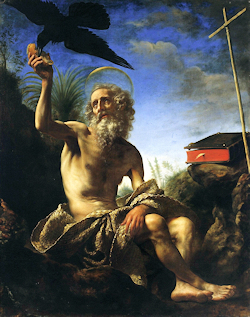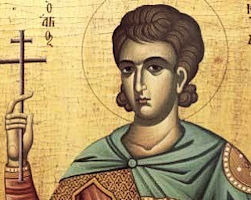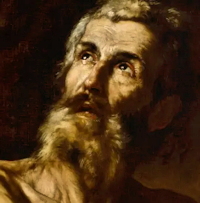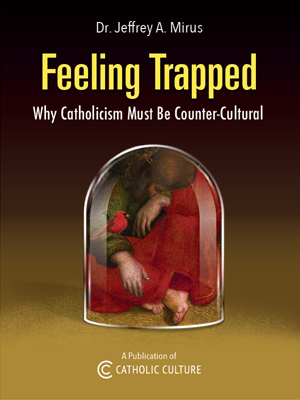Christmas: January 10th
Saturday after Epiphany
Other Commemorations: St. Paul, the First Hermit (RM); St. Miltiades, Pope and Martyr (RM)
» Enjoy our Liturgical Seasons series of e-books!
Today is the Saturday after Epiphany. No feast of a saint is celebrated. This is the last day in the Christmas season when we focus on the feast of the Epiphany.
In the High Middle Ages popular devotion turned to the Magi themselves on January 6. They are called "saints" for the first time in the writings of Archbishop Hildebert of Tours (1133). In the twelfth century their veneration spread over all of Europe. The authorities of the Church did not prohibit this cult, and Epiphany acquired the popular name of "Feast of the Three Holy Kings" in most countries of Europe.
The name Magi is not a Hebrew word, but of Indo-European origin, and means "great, illustrious." Saint Matthew mentioned the term without explanation because it was well known to the people of Palestine. The Magi originated in Media (Persia), and their caste later spread to other Oriental countries. They were a highly esteemed class of priestly scholars, devoting themselves not only to religion but also to the study of natural sciences, medicine, mathematics, astronomy, and astrology. In several countries they were members of the king's council.
Where did the Magi come from? Saint Matthew gives a general answer: "Wise men from the East." Speaking in modern terms, it could have been from any one of the countries of Arabia, Iraq, Iran, Afghanistan, or India. It has never been exactly determined from which of these countries they came.
 Quite early in the Christian era a popular tradition conferred on them the title of "kings". This tradition became universal at the end of the sixth century. It was based on Biblical prophecies which described the conversion of the pagans and, although not referring to the Magi, were applied to their visit:
Quite early in the Christian era a popular tradition conferred on them the title of "kings". This tradition became universal at the end of the sixth century. It was based on Biblical prophecies which described the conversion of the pagans and, although not referring to the Magi, were applied to their visit:
The kings of Tharsis and the islands shall offer presents: the kings of the Arabians and of Sheba shall bring gifts. (Psalms 71, 10) The kings shall walk in the brightness of thy rising.... They all shall come from Sheba, bringing gold and frankincense. (Isaiah 60, 3-6)The Gospel does not tell us how many they were. The Christians in the Orient had an old tradition of twelve Magi. In early paintings and mosaics they are represented as two, three, four, and even more. In the occidental Church a slowly spreading tradition put their number at three. It does not seem to have any historical foundation, but was probably based on the fact of the threefold presents. Another reason for the number three was the early legend that they represented all humanity in its three great races. Thus one of them was pictured as a member of the black race, and this choice seemed to be confirmed by the Bible:
Let the great ones come forth from Egypt, let Ethiopia stretch out her arms to God. (Psalms 67, 32)The book Collectanea et Flores, ascribed to Saint Bede the Venerable (735), records an earlier legend of their names and appearance:
The first was called Melchior; he was an old man, with white hair and long beard; he offered gold to the Lord as to his king. The second, Gaspar by name, young, beardless, of ruddy hue, offered to Jesus his gift of incense, the homage due to Divinity. The third, of black complexion, with heavy beard, was called Baltasar; the myrrh he held in his hands prefigured the death of the Son of man.There is an old legend that when many years had passed the Magi were visited by Saint Thomas the Apostle, who, after instructing them in Christianity, baptized them. They were then ordained to the priesthood and made bishops. It is said that once more the star of Bethlehem appeared to them and reunited them toward the end of their lives. "The city of Sewa in the Orient" is given as the place of their burial.
The legendary relics of the Magi were brought from Constantinople to Milan in the sixth century. In 1164 Emperor Frederick Barbarossa obtained them from the archbishop of Milan and transferred them to Cologne. Their shrine in Cologne was, and still is, the center of many pilgrimages.
St. Paul, Hermit
St. Paul is called "the first hermit" in the Missal and Breviary, a rare distinction, for such titles are seldom  appended. Our saint was the standard-bearer of those courageous men who for the love of Christ left the world and entered the wilderness to dedicate themselves wholly to contemplation amid all the privations of desert life. The hermits were the great men of prayer in those difficult times when the Church was locked in fierce struggle with heresy after heresy. For centuries the example of their lives served as the school of Christian perfection. Their action set the background for the rise of monasticism and religious orders in the Church.
appended. Our saint was the standard-bearer of those courageous men who for the love of Christ left the world and entered the wilderness to dedicate themselves wholly to contemplation amid all the privations of desert life. The hermits were the great men of prayer in those difficult times when the Church was locked in fierce struggle with heresy after heresy. For centuries the example of their lives served as the school of Christian perfection. Their action set the background for the rise of monasticism and religious orders in the Church.
The Breviary retains an edifying legend concerning today's saint. One day St. Anthony, then ninety, was divinely inspired to visit the hermit Paul. Though they had never met previously, each greeted the other correctly by name. While they were conversing at length on spiritual matters, the raven that had always brought Paul half a loaf of bread, came with a whole loaf. As the raven flew away, Paul said: "See, the Lord, who is truly good and merciful, has sent us food. Every day for sixty years I have received half a loaf, but with your arrival Christ sent His servants a double ration." Giving thanks, they ate by a spring.
After a brief rest, they again gave thanks, as was their custom, and spent the whole night praising God. At daybreak Paul informed Anthony of his approaching death and asked him to fetch the cloak he had received from St. Athanasius, that he might wrap himself in it. Later, as Anthony was returning from his visit, he saw Paul's soul ascending to heaven escorted by choirs of angels and surrounded by prophets and apostles. Further traditional matter may be found in The Life of Paul the Hermit, written by St. Jerome about the year 376.
Patronage: Clothing industry; weavers; basket weavers; hermits; Order of Saint Paul the First Hermit
Symbols and Representation: Dead man whose grave is being dug by a lion; man being brought food by a bird; man clad in rough garments made of leaves or skins; old man, clothed with palm-leaves, and seated under a palm-tree, near which are a river and loaf of bread; pictured with Saint Anthony the Abbot.
Highlights and Things to Do:
- Bake a loaf of bread to celebrate this feast, as it is recounted in the Golden Legend how St. Paul received his daily bread every day from God.
- Read St. Jerome's account of the Life of St. Paul.
- The Order of St. Paul the Hermit (Paulines) runs the Shrine of Our Lady of Czestochowa in Doylestown, PA. Read more about the order and if in the neighborhood pay a visit (or a virtual visit) to the Shrine.
- See the Community of Blessed Eusebius which prayerfully supports the Order of Saint Paul the First Hermit.
- Read about St. Paul the Hermit:
- Catholic Encyclopedia
- The Golden Legend
- Catholic Ireland
- Saints Stories for All Ages
- CatholicSaints.info
- See the statue of St. Paul the Hermit at St. Peter's Basilica Colonnade.
- See some iconography of St. Paul.
Pope St. Miltiades (also known as St. Melchiades)
 Two popes had been exiled by Emperor Maxentius, and for nearly two more years the Church in Rome was steeped in turmoil, making it impossible to choose a pope. Finally, Miltiades, an African, was elected. He had served as a priest under Marcellinus during the terrible Diocletian persecution. Now, however, he witnessed the effects of a kinder, more generous Roman government. Indeed, the Church would actually be favored with splendid gifts. By 311 the Church began to enjoy a peace resulting from a decree of toleration issued in both the East and the West. Emperor Maxentius ordered the properties of the Church restored. These included the land and buildings that had been confiscated during the reign of Emperor Diocletian. In 312 for the first time since the outbreak of persecution, a pope was able to preside over the celebration of Easter in full possession of the Church's holy assets.
Two popes had been exiled by Emperor Maxentius, and for nearly two more years the Church in Rome was steeped in turmoil, making it impossible to choose a pope. Finally, Miltiades, an African, was elected. He had served as a priest under Marcellinus during the terrible Diocletian persecution. Now, however, he witnessed the effects of a kinder, more generous Roman government. Indeed, the Church would actually be favored with splendid gifts. By 311 the Church began to enjoy a peace resulting from a decree of toleration issued in both the East and the West. Emperor Maxentius ordered the properties of the Church restored. These included the land and buildings that had been confiscated during the reign of Emperor Diocletian. In 312 for the first time since the outbreak of persecution, a pope was able to preside over the celebration of Easter in full possession of the Church's holy assets.
Pope Miltiades worked diligently in a difficult time of transition. His edicts included forbidding the Christians to fast on Thursday and Sunday (the days during which the pagans kept their fasts) and directing that the Eucharist plate blessed by the bishop be carried to the various churches.
Constantine, having been proclaimed emperor in Gaul, now marched on Rome. The sign of the cross had been revealed to him in a vision where he was told that "by this sign shalt thou conquer." Constantine ordered his standards changed, and for the first time in history, the sign of peace was borne by an army. Constantine's legions defeated Maxentius, and the year 312 ushered in a new era, an era of peace; the Christians were truly set free. During the emperor's stay in Rome, the famous Lateran palace was given to Pope Miltiades by Fausta, Constantine's wife. The Lateran served as the papal residence for some four hundred years.
Less than a year later, a schism broke out in North Africa. Headed by a rigorist named Donatus, the faction objected to the policies of the bishop of Carthage, Caecilian. Bypassing the pope, they appealed directly to Constantine to intervene. The emperor, annoyed that he should be called on to settle disputes among the clergy, commissioned Miltiades and three other Gallic bishops to rectify the matter. The pope gathered fifteen additional bishops and held a synod in the great Lateran palace. The decision of this synod was to condemn Donatus and his party and to support the true bishop, Caecilian. The Donatists (as they later became called) appealed again to Constantine, but by the time another council could be called, Pope Miltiades had died.
St. Miltiades was an excellent pontiff who guided the Church wisely during a difficult time of changeover. Pope Miltiades was the last pope to be buried in a catacomb in the cemetery of Calixtus. His feasts was originally celebrated on December 10, but moved to January 10 in the calendar revision of 1969.
—Excerpted from The Popes: A Papal History, J.V. Bartlett
Highlights and Things to Do:
- Read more about the Pope St. Miltiades:
- St. Miltiades is often venerated as one of 3 of the black popes.
- Pope St. Miltiades is buried in the Catacombs of St. Calllixtus along the Appian Way.






